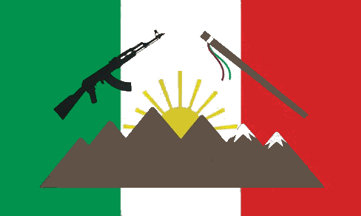 image by Jaume Ollé and Esteban Rivera, 4 October 2020
image by Jaume Ollé and Esteban Rivera, 4 October 2020Source

Last modified: 2024-04-12 by daniel rentería
Keywords: colombia |
Links: FOTW homepage |
search |
disclaimer and copyright |
write us |
mirrors
Editorial Remark: It must be noted that all the opinions are of the authors and not of FOTW. Our site is non-political and concentrates only on vexillological issues.
See also:
 image by Jaume Ollé and Esteban Rivera, 4 October 2020
image by Jaume Ollé and Esteban Rivera, 4 October 2020
Source
In 1984 a new guerrilla group emerged in Colombia: the
Movimiento Armado Quintín Lame (Quintin Lame Armed Movement),
named after a NASA tribe leader (Manuel Quintín Lame Chantre),
it was a guerrilla group, thus an illegal armed organization. It
entered peace talks with Colombia's government and laid down its
weapons in May 1991.
E.R., 23 March 2005
Today on Caracol TV news they showed a report of previous peace processes
with armed groups in the country, in the wake of today's signing of the so
called "peace agreement" between the government and the oldest guerrilla, FARC.
In the image, one can see a true picture of the Quintin Lame Armed Movement. I
know for fact that both the flags above were indeed based on previously seen
images but unfortunately at the time neither Jaume nor I had the chance to get
the chance to have a reliable picture of one of these, and both illustrations
are reconstructions. Now, I can finally provide a trustworthy image.
The
most common and accepted version is a horizontal flag with three equally divided
vertical stripes, the left being red, the middle white and the right green. On
the bottom there is a mountain range (symbolizing the terrain in which the group
was located) and a sun with nine rays emerges from the top of the middle
mountain range. The mountain range has a snowy top on the right (this means the
three main mountain ranges that exist in the country: the Cordillera Occidental
(Western mountain Range), Central (Central), and Oriental (Eastern), the Eastern
one having snow on the top. Above the mountain range there is a gun on the left
(AK-47) (a symbol of armed struggle) and an indigenous baton on the right with
two streamers (red and green) (the same colors as the
CRIC (a symbol of ancestral authority by the
indigenous people). That is the flag seen here:
http://agenciadenoticias.unal.edu.co/uploads/pics/AgenciaNoticias_080915-01_07.jpg
(source:
http://agenciadenoticias.unal.edu.co/detalle/article/quintin-lame-el-grupo-que-reconstruyo-su-identidad-de-paz.html).
The flag is seen on the front cover of the book "Guerra propia, guerra ajena"
(Own war, alien war) by Daniel Ricardo Peñaranda published in 2015 by IEPRI (Instituto
de Estudios PolĂticos y Relaciones Internacionales, Political Studies and
Foreign Relations Institute) of the Universidad Nacional de Colombia (National
Universoty of Colombia) (sources:
https://www.youtube.com/watch?v=nVfoAVhMb10 and
http://www.elespectador.com/noticias/nacional/quintin-lame-guerra-propia-guerra-ajena-articulo-584475)
and sponsored CNMH (Centro Nacional de Memoria HistĂłrica, Historical Memory
National Center) which is an official organization part of the
Administrative Department DPS (Departamento
para la Prosperidad Social, Social Prosperity Department). The PDF version of
the book is available at
http://www.centrodememoriahistorica.gov.co/....pdf .The same author had
published another study in 2010 for additional information:
http://www.cedema.org/uploads/MAQL_Penaranda.pdf ("El
Movimiento Armado
QuintĂn Lame (MAQL): Una guerra dentro de otra guerra", "Quintin Lame Armed
Movement (MAQL): A war inside another war"), and from this study, on chapter 8
titled "Entre la “guerra propia” y la “guerra ajena”" (Between the "own war" and
the "alien war") is where he took the title for the 2015 book.
Other flag
variants include:
- Same as the above and it adds the
inscription "MOVIMIENTO ARMADO" above the mountain range in black capital
letters (most likely Times New Roman Font type) and inside the mountain range
"QUINTIN LAME" in white capitals (see
image). Source: screenshot from TV news Caracol aired
today. Notice that the flag has the same inscription in the obverse as well as
the reverse.
-
http://agenciadenoticias.unal.edu.co/uploads/pics/AgenciaNoticias_240915-01_04.jpg
(source:
http://agenciadenoticias.unal.edu.co/detalle/article/experiencias-indigenas-aportan-al-proceso-de-paz.html).
This version lacks the details of the original, so it is a sloppy drawing of the
flag. It is also an erroneous depiction because it features the the baton on the
left and the gun on the right.
-
http://contrapunto.com/ (source:
http://contrapunto.com/noticia/nodos-y-redes-18527/) Same image as the above
one.
-
http://www.cedema.org/uploads/cql-colombia.jpg (source:
http://www.cedema.org/ver.php?id=2938). This is an early logo
version. It
has three vertical stripes, on the left one is a gun (unidentified, possibly a
H&K G-3, available in the country at the time), in the middle the name and the
motto: on top "EN UNIDAD CON EL PUEBLO" (Together with the people), below "HASTA
LA VICTORIA" (Until victory (is achieved)), and below that "COMANDO QUINTĂŤN
LAME" (Quintin Lame Command). The group was at the beginning identified as "Comando
QuintĂn Lame" (source:
https://en.wikipedia.org/wiki/Movimiento_Armado_Quintin_Lame).
- Another
flag is this one (see image) as found in the book "Guerra propia, guerra ajena" (
http://www.centrodememoriahistorica.gov.co/....pdf) on page 398. However it
is too blurry for positive identification.
The group emerged after a
local strong opposition to the Farc's presence in the traditionally occupied
indigenous territories, and that is why it is said they fought a war (against
the Farc) inside a (bigger) war (the guerrillas vs. the government). They took
their name QuintĂn Lame from indigenous leader Manuel QuintĂn Lame Chantre, who
advocated for an independent and autonomous indigenous nation.
The
demobilized combatants of this group seemed to be represented by this flag (http://www.gobiernomayor.org/site/images/stories/Desmovilizados_Quintin_Lame.jpg,
source:
http://www.gobiernomayor.org/...quintin-lame), a horizontal flag with the
same color composition as the armed movement, and inside the white stripe, a
circular (ineligible) inscription in black that seems to portray the last name
"Lame".
Another organization successor to the struggle for land, derived
from the same inspiration from Manuel QuintĂn Lame, is the "Movimiento de los
Sin Tierra: Nietos de Manuel QuintĂn Lame" (Landless Movement: Grandchildren of
Manuel Quintin Lame), which features this flag:
-
http://1.bp.blogspot.com/....png (source:
http://remapvalle.blogspot.com.co/2011/12/conmemoracion-y-acompanamiento-las.html)
-
http://2.bp.blogspot.com/....jpg (source:
http://jesicapsicologia.blogspot.com.co/2014/11/2.html)
-
https://prensalibrecauca.files.wordpress.com/2011/12/los-nietos.jpg (source:
https://prensalibrecauca.wordpress.com/2012/07/21/comunicado-a-la-opinion-publica-movimiento-de-los-sin-tierra-nietos-de-quintin-lame/)
In the flag, the portrait of QuintĂn Lame is a cropped image of this
picture:
https://en.wikipedia.org/wiki/Quint%C3%ADn_Lame#/media/File:Quintin_detenido.jpg,
in the middle of a horizontal flag, with three horizontal stripes: the top being
green, the middle and narrower being red, and the bottom being black and
measures exactly the same as the top one, and below the name of the movement in
white capitals.
This group is known to be established on August 6, 2006
(sources:
http://www.eltiempo.com/,
https://www.desdeabajo.info and
http://prensarural.org/)
Esteban Rivera, 26 September 2016
The top image above is also found on the front cover of the book "Guerra propia, guerra ajena" (Own war, alien war) by Daniel Ricardo Peñaranda published in 2015 (http://www.centrodememoriahistorica.gov.co). The flag features three equal sized vertical stripes, green, white and red, displaying an AK-47 on the left (a symbol of armed struggle) in black outline and on the right a baton (hand piece) (a symbol of traditional indigenous authority) in black as well, on the top, followed by a six-peaks mountain range (the last two on the right featuring snow on the top, called Paramo) which are the Nevado del RuĂz, Nevado del Tolima, Nevado de Santa Isabel, Nevado El Cisne, Nevado del QuindĂo and Paramillo de Santa Rosa, all of them part of the "Parque Nacional Natural Los Nevados" (English: The Nevados National Natural Park) with an emerging nine-ray sun in the middle (featured only from the half up).
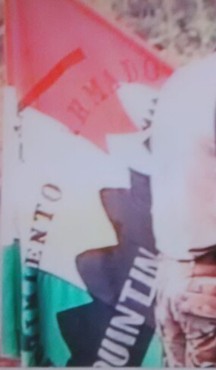 image located by Esteban Rivera, 4 October 2020
image located by Esteban Rivera, 4 October 2020
Source: screenshot
of Caracol TV news broadcast on September 26, 2016
This version features the same horizontal
flag with the same color composition, displaying an AK-47 on the left in black outline and on the right a baton in black as well, on
the top, followed by the inscription "MOVIMIENTO ARMADO" in black capital
letters in semicircular form and below a mountain range in black and inside
the inscription "QUINTIN LAME" in white capital letters.
Esteban Rivera, 4 October 2020
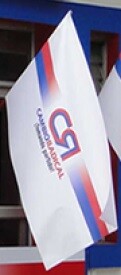
.gif) images located by Esteban
Rivera, 4 February 2022
images located by Esteban
Rivera, 4 February 2022
Cambio Radical (English: Radical Change) is a political movement that emerged
during the last year of the tenure of then president Ernesto Samper (1994-1998),
in which a faction of the Liberal Party was not
happy with the new social democratic route the party was moving towards. The
first gathering towards creating a new party was in 1996 and its formal
establishment and political status recognition came a year after in 1997. As
such, a more right-wing faction of the party split away and formed Radical
Change".
Sources:
http://www.partidocambioradical.org/acerca-de-nosotros
http://www.partidocambioradical.org/nuestra-historia
https://es.wikipedia.org/wiki/Partido_Cambio_Radical
The flag is the
logo (http://www.partidocambioradical.org/wp-content/uploads/2018/08/logo-Cambio-Radical-Standard.png)
over a white background. The logo is the letters "C" and "R" in capitals, in red
and white outline, symbolizing both of its tendencies (that is: Liberal and
Conservative, which are its founding members).
Esteban Rivera, 4
February 2022
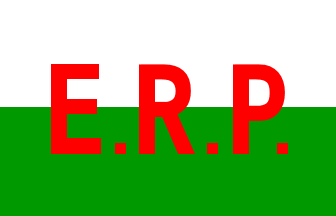 image by Eugene Ipavec, 25 October 2005
image by Eugene Ipavec, 25 October 2005
The flag of the ERP (Ejército Revolucionario del Pueblo, or
Revolutionary People's Army), a breakaway faction of the ELN. The ERP was formed in 1996. The
lettering style is the same as the ELN, only the color scheme is
different.
Source: www.geocities.com/ta-erpkomm.html.
E.R., 25 October 2005
In recent news, the ERP has fully demobilized on April 30,
2007 as stated by the Minister of Defense of Colombia. This day,
the last 18 combatants from this ELN
breakaway independent faction demobilized after starting military
actions in August 10, 1996. The total number of demobilized
illegal armed fighters, including the last 18, is 54 during the
whole month of April, in a series of multiple demobilizations.
The faction operated in the municipalities of San Jacinto,
Maríalabaja, El Carmen de Bolívar, San Juan Nepomuceno, located
in the Department of Bolivar and the
municipalities of Ovejas, Chalán, Colosó and Las Palmitas,
located in the Department of Sucre.
Among the combatants are 16 women and two newly born children.
This demobilization process took place in part due to the
pressure of the Army, but also from the
FARC,
another guerrilla force who is battling other guerrillas (i.e.
the ELN ) in order to gain superiority.
Sources: La FM
adiostation, El
Tiempo newspaper, Military
Forces General Command, Semana
magazine.
E.R., 9 June 2007
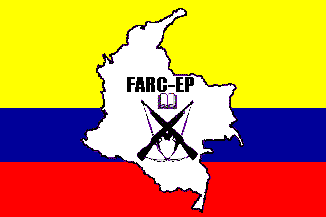 image by Pascal Gross and Guillermo Aveledo, 3
June 2000
image by Pascal Gross and Guillermo Aveledo, 3
June 2000
Emblem.jpg) image contributed by E.R., 24 July 2005
image contributed by E.R., 24 July 2005
I found the official site of the FARC guerrilla group on the web, and you can
see their flag. It's the same as the colombian flag, but it has a Colombian map
along with two assault rifles crossed . There's also a little squared thing, but
I can't see much. The link to it is burn.ucsd.edu/~farc-ep.
Their official name is: Fuerzas Armadas Revolucionarias de
Colombia-Ejército del Pueblo (FARC-EP) or Revolutionary Armed
Force of Colombia-People's Army. The guerrilla group known as
FARC-EP was created in 1964.
Ramiro Rivera Sanchez,19 January 1999
I believe that the" little squared thing" is an open
book.
Jorge Candeias,20 January 1999
Revolutionary Armed Forces, People's Army (FARC-EP Fuerzas
Arnadas Revolucionarias de Colombia - Ejercito Popular) - This
well-known guerrilla group is the main guerrilla movement in
Colombia, above from the
National Liberation Army (ELN). The flag of the FARC-EP is a regular
Colombian tricolor with the group's logo on its centre. The logo
consists of a Colombian continental map, in white, fimbriated in
black. Within the map we see the letters 'FARC-EP' in a bold
type, an open book and a pair of crossed, semi-automatic, rifles.
Guillermo Aveledo, 3 June 2000
The correct name of the movement is: Fuerzas Armadas
Revolucionarias de Colombia - Ejercito del Pueblo. A short
presentation of the FARC, based on Courrier International
#711, 17 June 2004 (French translation of a paper by Eduardo
Pizarro Leongomez, originally published in El Tiempo,
Bogota): On 9 April 1948, the Liberal leader Jorge Eliecer
Galtan was murdered, which triggered violent riots in Bogota,
known as Bogotazo. The next ten years are known as the Violencia
period, a civil war between the Liberals and the Conservatives
that caused more than 200,000 dead. In 1958, the two parties
signed the pact of National Front, by which they abandoned
violence and shared the power. The President of the Republic was
alternatively chosen in each party. The system lasted until 1974.
On 27 May 1964, the Colombian army attacked Marquetalia, which
was the headquarters of Communist revolutionaries and farmers'
self-defense militia, ruled by Manuel Marulanda, aka Tirofijo
(Bang on target). Following the assault, the militia were
organized into guerillas. Initially called Frente Sur (Front
South), the guerillas were renamed FARC two years later. The FARC
were reorganized and renamed FARC-EP in 1982. On 28 March 1984,
the FARC-EP signed an agreement in La Uribe with the
Colombian government. A cease-of-fire was implemented on 28 May.
The agreement included the creation of a legal political party by
the FARC-EP, called UP (Patriotic Union). More than 3,500 members
of the UP were murdered in the next two years, including two
candidates to the Presidential election. In December 1990, the
bombing of the Casa Verde, the FARC-EP headquarters, by
the Colombian army ended the peace process. A new round of
negotiations started on 7 January 1999 between the FARC-EP and
Andres Pastrana's government in the demilitarized area of Caguan
(42,000 sq. km). The area was placed under the control of the
FARC-EP until the breakdown of the negotiations in February 2002.
The FARC have today some 15,000-17,000 members.
FARC-EP homepage at www.farcep.org.
Ivan Sache, 27 December 2004
From www.tkb.org:
"Mothertongue Name: Fuerzas Armadas Revolucionarias de
Colombia (FARC).
Aliases: Fuerzas Armadas Revolucionarias de Colombia - Ejercito
del Pueblo (FARC-EP).
Base of Operation: Colombia.
Founding Philosophy: The Revolutionary Armed Forces of Colombia
(FARC) grew out of the Colombian Communist Party of the 1960s.
Unsurprisingly, the FARC was founded as a Communist organization.
The FARC leaned towards the Marxist strain of Communism and
received a limited amount of funding from the Soviet Union during
the Cold War. The FARC's stated goal is to overthrow the current
democratic government of Colombia and replace it with a Communist
government.
While the FARC is undoubtedly the largest and oldest of the
Communist insurgent groups of Colombia, it is not necessarily the
most dogmatic in its devotion to the Marxist ideology. In fact,
the FARC's growing hand in cocaine trafficking, and even
production, coupled with its on-again, off-again peace talks with
the Colombian government, indicate that the ideological backbone
of the FARC is at best, ill-defined. However, a significant
portion of the FARC's leadership, including FARC chief Manuel
Marulanda, have been part of the organization since its founding
and are presumably still dedicated to its Marxist ideology. The
FARC continues to wage a war of words devoted to Marxist
principles, despite the fact that many of its battles are fought
with the less idealistic motive of controlling the illicit drug
inustry.
Current Goals: Today, the FARC's primary goal is territorial
control within Colombia. The FARC has several sources for the
money it needs to pursue this goal. The majority of its funding
comes from the cocaine trade, but the FARC also pursues
kidnapping, extortion, and hijacking. In addition to these
operations, the FARC also attacks Colombian political and
military installations. Its activities frequently disrupt
economic activity in Colombia, particularly when conflicts with
Colombia's rightist paramilitary groups break out. Ordinary
Colombian citizens are often caught in the middle of this violent
and bloody struggle.
The FARC's larger goals are a matter for speculation. For four
decades the FARC has struggled to overthrow the Colombian
government. This does not seem likely unless the FARC
dramatically shifts its approach and increases its strength. The
more likely outcome is that the FARC will continue to destabilize
Colombian democracy but never actually overthrow the government.
Furthermore, the FARC's recent participation in peace talks
demonstrates a certain willingness to negotiate with its
ideological enemies. The FARC's ideological commitment is in
doubt, but its immediate goals are not. The FARC aims to maintain
its significant financial and territorial power. From all
indications, the FARC will continue its violent criminal action
for the foreseeable future."
More information at en.wikipedia.org.
E.R., 8 June 2005
1) 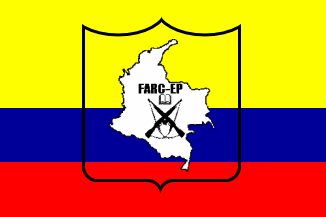 image by Eugene Ipavec, Pascal Gross and Guillermo
Aveledo, 14 February 2006
image by Eugene Ipavec, Pascal Gross and Guillermo
Aveledo, 14 February 2006
A photo of a variant
with shield of the FARC flag, appeared on the front page of
today's (29 June 2001) Miami Herald, with the headline
"Rebels Free Colombian Troops" and the caption
describing the release of "242 government soldiers and
police released Thursday by the Revolutionary Armed Forces of
Colombia [FARC] outside La Macarena, in the heart of a 26,000
square-mile area of jungle and savanna under FARC control. The
troops were freed by the rebels in a unilateral hand-over after
more than three years in captivity".
Al Kirsch and Jaume Ollé, 29 June 2001
The variant is based on photos at FARC news
website and SEMANA magazine.
E.R., 14 February 2006
2) 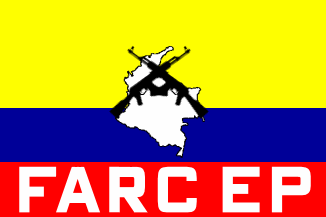 image by Eugene Ipavec, 17 March 2006
image by Eugene Ipavec, 17 March 2006
On March 8, 2006, the biggest demobilization yet (outside
peace process with the Colombian government) of a guerrilla
group, took place on the Department of Tolima. There a FARC
guerrilla structure laid down its weapons on a ceremony headed by
the Alto Comisionado Para La Paz (High Commissioner For Peace).
During this ceremony a new FARC flag variant came to light.
Source: El
Mundo newspaper, from the city of Medellín.
E.R., 17 March 2006
3) 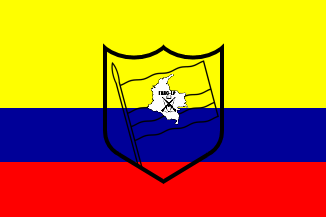 image by Eugene Ipavec, 27 May 2006
image by Eugene Ipavec, 27 May 2006
Another variant of the flag of the Farc Colombian guerrilla.
The flag is the same tricolor flag of Colombia, plus the Farc
emblem on the middle (outlined only, not in color).
Source: Farc 2006 calendar at www.farcep.org.
E.R., 27 May 2006
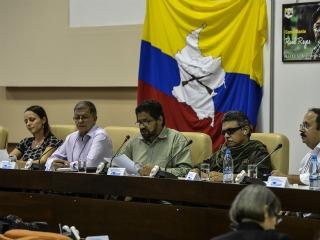 image located by Esteban Rivera, 31 January 2013
image located by Esteban Rivera, 31 January 2013
There's currently some direct conversations being held in Havana between the
Colombian government and the Farc. During these talks, a variant flag can be
observed:
Image:
http://ntn24-img.s3.amazonaws.com/sites/default/files/imagecache/320x240/farc_dialogos_colombia_afp_320_.jpg
Source:
NTN24,
and allied broadcast channel of RCN news channel)
Esteban Rivera, 31 January 2013
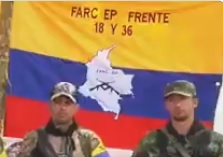 located by Esteban Rivera, 2 February 2024Source: RTVC News
Since its inception, Farc has not had any major or noteworthy splinter
groups, aside from the matter of the newer M-19 organization, of
which the current president was a member of (source:
the Spanish newspaper El PaĂs).
M-19 was made up mostly of former Farc members. Perhaps the only noticeable unit
was known as Comando "Ricardo Franco", also known as the Frente (Sur) "Ricardo Franco", (1982-1988) which seems to have not used a flag.
located by Esteban Rivera, 2 February 2024Source: RTVC News
Since its inception, Farc has not had any major or noteworthy splinter
groups, aside from the matter of the newer M-19 organization, of
which the current president was a member of (source:
the Spanish newspaper El PaĂs).
M-19 was made up mostly of former Farc members. Perhaps the only noticeable unit
was known as Comando "Ricardo Franco", also known as the Frente (Sur) "Ricardo Franco", (1982-1988) which seems to have not used a flag.
This illegal armed organization, considered terrorist by many multilateral organizations and countries for most of its existence, did not have proper flags for each of its units (structured as follows, from top to bottom: Estado Mayor Central or Central General Staff in English; Bloques [de Frentes] or [Fronts'] Blocks in English; Comando Conjunto or Joint Command in English; Frente or Front in English, Columna or Column in English; CompañĂa or Company in English; Guerrilla; Escuadra or Squad in English; and Unidad táctica de comba or Tactical Combat Unit in English.) Only one for the organization as a whole, a new discovery is made when several Units display flags, appearing in a recent broadcast aired on January 31, 2024 (source: RTVC Noticias).
Since the demobilization of the majority of its combatants in 2016, (there are still armed illegal organizations derived from the "original" calling themselves the rightful successors, i.e. "Estado Mayor Central" and "Segunda Marquetalia" or Second Marquetalia in English) this is the first time that either a unit within Farc or supposed succesor yields its own flag.
In particular it is worth noticing that before the so called formal
demobilization (November 24, 2016) and the subsequent referendum, these "Frentes" had been part of the regional Bloque Noroccidental
"Iván RĂos", or in English "Iván RĂos" Northwestern Block, which had influence
over the Departments of Antioquia, ChocĂł, CĂłrdoba, and slight influence in
Caldas. At this time, two fronts were respectively known as "Frente 18, Cacique Coyará" or 18th
Front, "Chieftain Coyara" in English; and Frente 36, Jair Aldana Baquero; both operating in the Department of
Antioquia and now part of the "Segunda Marquetalia".
Esteban Rivera, 2 February 2024